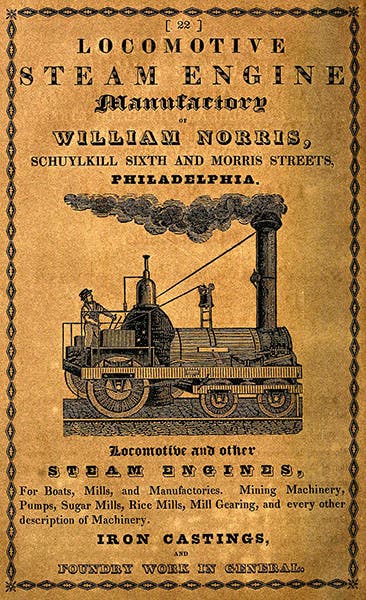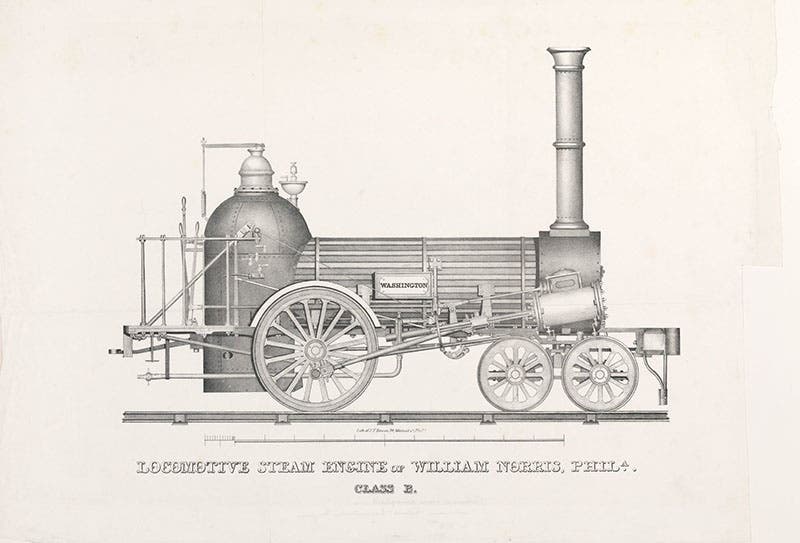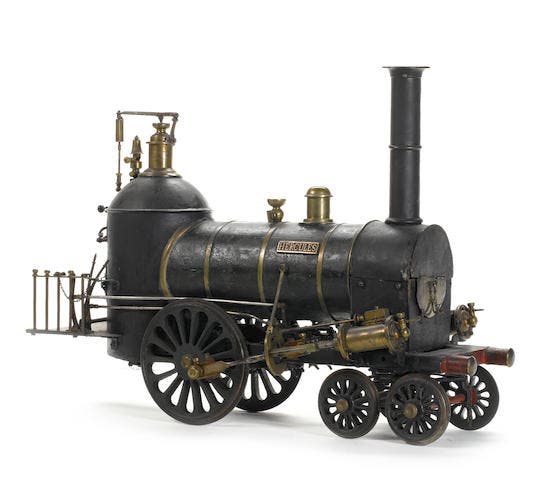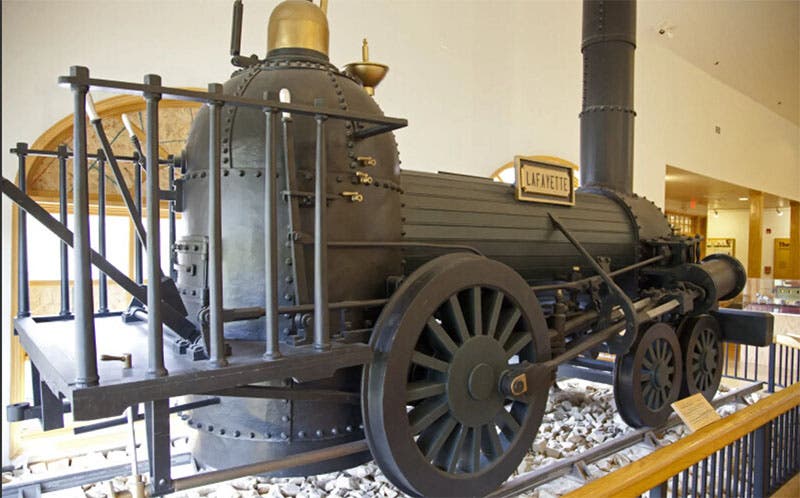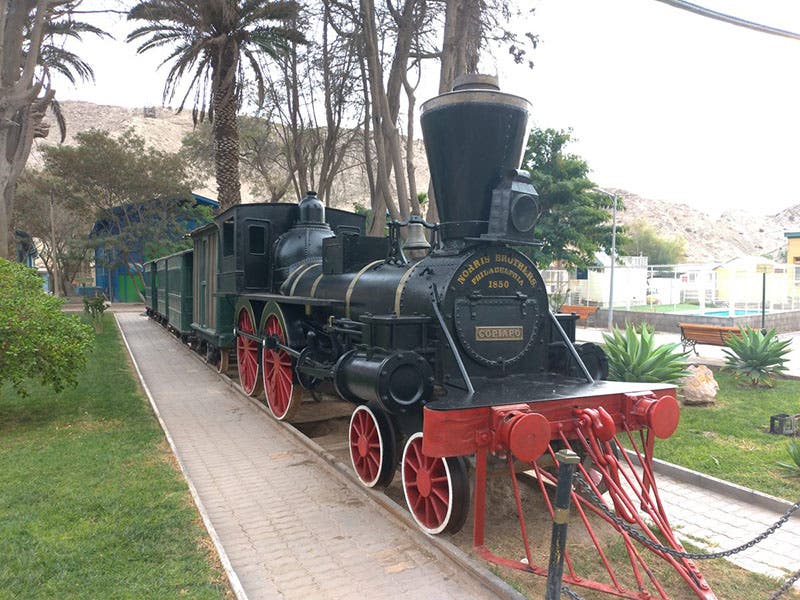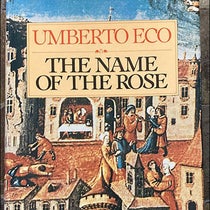Scientist of the Day - William Norris
William Norris, an American locomotive manufacturer, died on Jan. 5, 1867, at the age of 64. Norris is about as shadowy a figure as has ever infiltrated these anniversaries. We know he lived in Philadelphia and that he was a dry goods merchant until, in 1832, he teamed up with Western explorer Stephen H. Long, still a major in the U.S. Army Corps of Topographical Engineers, to build locomotives. The railroad era in the United States had begun in 1830 with the founding of the Baltimore & Ohio Railroad, and railways were springing up everywhere. Long apparently designed the very first locomotives for Norris, but he left almost immediately to do other things, so William teamed up with his brother, founded the Norris Locomotive Works in 1834, and built a large factory in Philadelphia, competing with the better-known Baldwin Locomotive Works. We have little idea who designed these locomotives – certainly not William, who had no engineering background – but Norris locomotives were soon a hot item. The firm had turned out 138 locomotives by 1841, and some 1000 more before William’s death in 1867, many of them being shipped to England and to Austria.
The most popular early Norris locomotive was what we now call a 4-2-0, meaning it had a four-wheel truck in the front, two main driving wheels, with no wheels following the drive wheels. This made it very maneuverable, with a great deal of traction (for the time). Norris’s day in the Sun came on July 10, 1836, when a locomotive named the George Washington pulled a ten-ton load up the Belmont Inclined Plane, a steep incline on the Philadelphia and Columbia Railroad, where the grade was 1:15, quite a challenge for these early locomotives. Before the George Washington, loads were pulled up the ramps by stationary steam engines, but that was a cumbersome process. Passing the Belmont inclined plane test gave the George Washington, and the Norris Locomotive Works, an instant reputation.
England had its own problem with inclines, especially a grade on the Birmingham and Gloucester Railroad called the Lickey incline. English engine manufacturers were unable, or unwilling, to supply locomotives to surmount the grade, and so the railroad imported 15 Norris locomotives, each of which could pull 75 tons up the incline. The British promptly made their own copies of the Norris locomotive and soon had quite a bevy of them at work pulling loads up hills, often as assist engines (bank engines). Austria also wanted Norris locomotives, and this time Norris himself (or his brother) went to Vienna to help set up a plant to manufacture locomotives locally. They apparently sold well.
Little survives today to attest to Norris’s great success as a locomotive manufacturer. There is no trace of the plant in Philadelphia. The only original Norris locomotive that I know about is in Copiapó, Chile, the first locomotive to run on a track in all of South America (sixth image). But this is a late engine, built in 1850, and quite different from the 4-2-0's that made the reputation of the Norris firm. The National Museum of American History at the Smithsonian has large lithograph drawings of several early Norris locomotives, including the George Washington, as does the Library Company of Philadelphia (second image), and other near-contemporary drawings of various Norris locomotives can be found. Best of all, there are several models that survive, the two that I know about having been made during the heyday of the Norris locomotive. One was built in Vienna in 1843, a 1:6 scale model of the Austria, which is just beautiful – it is now in the Science Museum in London (third image). The other sold at auction at Bonham's in 2008. I do not know the scale, but it is 27" long, and a handsome example of the model-maker’s art (fourth image).
In addition, there is a full-size wooden replica of the Norris locomotive Lafayette at the Allegheny Portage Railroad National Historic Site, a replica that was apparently built for the World's Columbian Exposition in Chicago in 1893. The Allegheny historic site is also supposed to have a scale model of the George Washington, but I have not seen a photo.
For those that want the nitty-gritty on Norris locomotives, we have a monograph, The Norris Locomotives, by P.C. Dewhurst, published in 1950 as Bulletin 79 for the Railway and Locomotive Historical Society. Written by an engineer, it examines such matters as the horsepower the George Washington would have had to produce, and the boiler pressure it would have required, to make it up the Belmont plane with its load. But even Dewhurst was unable to find any biographical details on William Norris, nor did he discover whom his design engineers might have been.
It may be that some model manufacturer has produced a small-scale model of the George Washington for a mass market, and I just haven’t found it yet. I hope so. I have a model of George Stephenson’s Rocket of 1829 in my office. It would be nice if it had a companion from across the pond.
William B. Ashworth, Jr., Consultant for the History of Science, Linda Hall Library and Associate Professor emeritus, Department of History, University of Missouri-Kansas City. Comments or corrections are welcome; please direct to ashworthw@umkc.edu.


